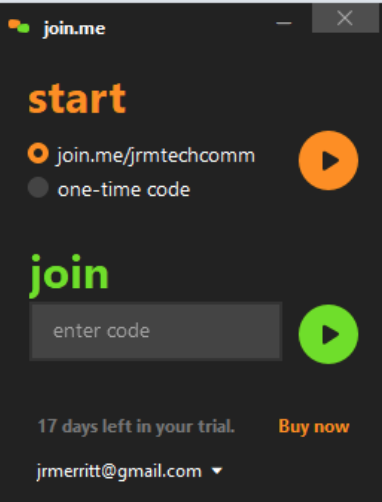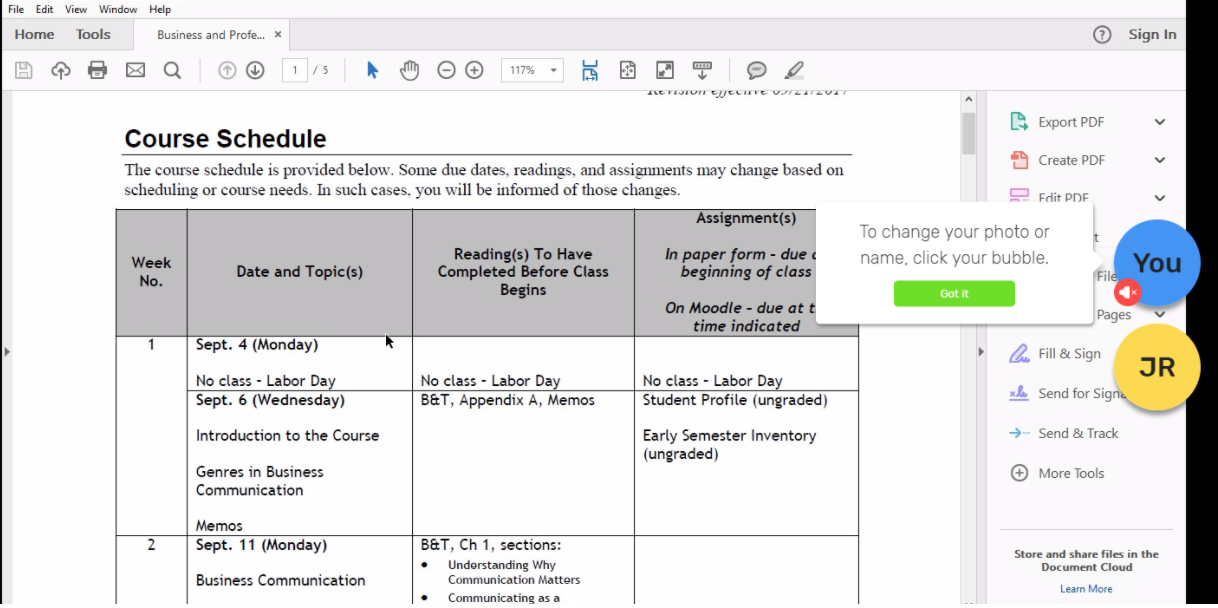join.me is an online meeting platform that provides desktop and mobile conferencing and screencasting abilities (PC Magazine, 2017). Join.me is considered a “freemium” conferencing platform: many of its features are available at no charge, making it a viable choice for collaboration among enterprises, both large and small, and private citizens who need to share screens. These benefits are extensible to non-profit and academic contexts as well, as libraries’ use of the platform (Johnston, 2012) partly demonstrates. Join.me can be used with systems more common in the academy; one example is Slack, a messaging system used in at least one rhetoric-oriented group (personal communication in CPTSC discussion, October 7, 2017). Join.me can be launched directly from a Slack channel. A more common model in industry might see a messaging system, such as Skype for Business, used for internal communications while join.me is used for communication across geography (as in the case of companies with multiple locations or partnering companies working together).
Operation, Interface, and Design
The join.me platform includes a base desktop application that runs on a host computer with Windows 7 or higher or Mac OS X 10.9 or higher. Meeting attendees can join a meeting using their browser; Chrome is recommended as other browsers may not handle audio or video correctly. Mobile users will find that they can join meetings if their device uses iOS or Android. (“System Requirements,” 2017). Once in the join.me sharing environment, users can share screens, video- or audio-conference, schedule events, “whiteboard” (share ideas and drawings on a virtual “canvas”), and perform other tasks depending on their device and package (“Features,” 2017).
The figures below show different screens and options associated with the join.me host and attendee environments.



The collective join.me interface is clean and, some would argue, fairly minimalistic. The interface itself is generally unobtrusive though noticeable given its chosen bright, “glowy” color selection. This selection of colors seems to permeate all of the join.me interfaces from desktop to mobile. I consider join.me a part of a distributed user interface (DUI; see Lozano, 2013) that is used in small- and large-group collaboration; this kind of distributed collaboration is unified in the end result and forms the basis for the collaborative model I propose for potential future applications between industry and academic or non-profit settings.
A Potential Transformative Model of Collaboration
In industry, collaboration is often seen as a means to an end—an end which is often fiscal and focused on competitive advantage and economic advantage very likely at the expense of other parties. In other words, the primary and often single beneficiaries of this collaboration are the collaborators themselves. Other members of a global, often capitalistically driven ecosystem do not always benefit; they often lose. I propose a model that counters this tendency—one that helps to promote an awareness of the benefits of cooperation and collaboration and incorporates join.me as the vehicle for collaboration.
Swartz & Triscari (2011) base their treatment of transformation in Mezirow’s concept of transformative learning (see Mezirow, 1995), one that begins with “negotiation of habits of mind” (Swartz & Triscari, 2011, p. 333) leading to a questioning of assumptions and, in time, a willingness to leave behind prior assumptions as part of forming a collaborative relationship. In their model, Swartz & Triscari adopt “an ecological perspective on human development and skills” (p. 334) and call for reflection and synergy in the transformative collaboration process.
The Swartz & Triscari model of transformative collaboration provides a basis for educating people in industry. Through mentorships (Goldsborough, 2009) among people in the academy/non-profit sectors and people in business, industry professionals can learn how theory, ecological concepts, and reflective practice relate intrinsically to the work they do in numerous fields. In these mentorships, communication would be facilitated with join.me as a free yet powerful platform for conversing, collaborating, and de-siloing. Groups of two or more can meet on a monthly basis (or more often if they wish) to discuss issues they face in their work, how the solutions in their collaborators’ contexts may be thought of differently, and how reflective practice may help each of them create solutions that consider the multiple perspectives of stakeholders in a shared ecosystem of which some of the participants may not have previously been aware.
Pedagogical Implications
This proposed model can include our students as well. join.me, while not transformative in itself, can be used in transformative interactions between students and industry partners in industry-academic course partnerships where communication is facilitated through the join.me platform (or, if the instructor prefers, a platform like Slack that is compatible with join.me). With a philosophical grounding in transformative learning (Mezirow, 1995) and constructivism (Boghossian, 2006), the dynamic between students and people in industry would include both mentorship, where students learn from industry experts about work in a given field, and reverse mentorship (Chen, 2013), in which students teach their industry partners about concepts in sustainability (Banerjee & Shastri, 2010), corporate-community ecology (Forbes & Jermier, 2010), and mindfulness (Caring-Lobel, 2016), leading to a dialogic co-creation of knowledge facilitated in large part by a virtual space collaboration.
References
Banerjee, P., & Shastri, V. (2010). Social responsibility and environmental sustainability in business: How organizations handle profits and social duties. New Delhi, India; Thousand Oaks, Calif.: Response Books.
Boghossian, P. (2006). Behaviorism, Constructivism, and Socratic Pedagogy. Educational Philosophy and Theory, 38(6), 713-722.
Caring-Lobel, A. (2016). Corporate Mindfulness and the Pathologization of Workplace Stress. In R. Purser, D. Forbes, & A. Burke (Eds.), Handbook of mindfulness: Culture, context, and social engagement (Mindfulness in behavioral health), 195-214. Cham: Springer.
Chen, Y. (2013). Effect of Reverse Mentoring on Traditional Mentoring Functions. Leadership and Management in Engineering, 13(3), 199-208.
Forbes, L., & Jermier, J. (2010). The New Corporate Environmentalism and The Ecology of Commerce. Organization & Environment, 23(4), 465-481.
Goldsborough, R. (2009). The great ones: A business fable: The transformative power of a mentor. Hoboken, N.J.: John Wiley.
Lozano, M. (2013). Distributed user interfaces: Usability and collaboration (Human-computer interaction series). London; New York: Springer.
Johnston, A. (2012). Using join.me to help library patrons. Library Hi Tech News, 29(8), 5-6.
Join.me | Features. (2017). Retrieved October 11, 2017, from https://www.join.me/features.
Join.me | Knowledge Base. (2017). Retrieved October 11, 2017, from https://help.join.me/s/article/ka11B000000oh7hQAA/joinme-c-joinme-systemrequirements?language=en_US.
PC Magazine| join.me. (2017). Retrieved October 10, 2017, from https://www.pcmag.com/article2/0,2817,2487376,00.asp.
Swartz, Ann L., & Triscari, Jacqlyn S. (2011). A Model of Transformative Collaboration. Adult Education Quarterly: A Journal of Research and Theory, 61(4), 324-340.
